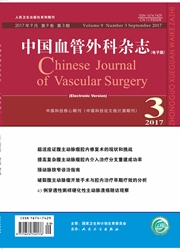

 中文摘要:
中文摘要:
目的比较多平面重建(MPR)技术与经验性定位在Stanford B型主动脉夹层腔内修复术中的临床应用价值。方法选择2012年5月至2013年3月Stanford B型主动脉夹层患者40例(A组):术前分别采用经验性和MPR两种方法获得C形臂的旋转角度和倾斜角度,比较两种方法的差异;术中采用MPR技术确定角度,统计支架释放后近端标记点的散开率和各种并发症的发生率。另42例Stanford B型主动脉夹层患者采用经验性方法释放支架(B组):计算近端标记点散开率和各种并发症的发生率。分析两组支架标记点散开率和并发症发生率。结果 A组内经验性方法和MPR方法之间旋转角度及倾斜角度比较,差异有统计学意义(P均【0.05);A、B两组标记点散开率比较,差异有统计学意义(5.0%vs 42.9%,P【0.05);A、B两组并发症发生率比较,差异有统计学意义(5.0%vs 21.4%,P【0.05)。结论结合MPR技术进行Stanford B型主动脉夹层腔内治疗术中定位调整,指导手术操作,具有较好的可行性、有效性及安全性。
 英文摘要:
英文摘要:
Objective To analyze application value of multi-planar reconstruction (MPR) in the aortic arch positioning of endovascular repair of type B aortic dissection. Methods A group of 40 patients (group A) was sampled from May 2012 to March 2013. The conventional and the MPR approaches were respectively introduced on positioning the aortic arch for surgery. Statistical significance of the difference of spin and tilt angles was obtained from the patients using both approaches before operation. The MPR data guided stent-grafting in this group. Another group of 42 patients (group B) was sampled and their stent graft placement was based on the conventional approach. Percentages of proximal distributed markers as well as incidences of complications were collected from both groups after stent graft placement. Results A significant difference was found between the conventional and the MPR approaches for spin angle as well as tilt angle (P<0.05). Percentage of proximal distributed markers of group A (5.0%) was significantly lower than that of group B (42.9%) (P<0.05). Incidence of complications of group A (5.0%) was also significantly lower than that of group B (21.4%) (P<0.05). Conclusion MPR technology can apply to intraoperative positioning adjustment. It is feasible in endovascular treatment of type B aortic dissection, and can effectively and safely guide surgical operations.
 同期刊论文项目
同期刊论文项目
 同项目期刊论文
同项目期刊论文
 期刊信息
期刊信息
